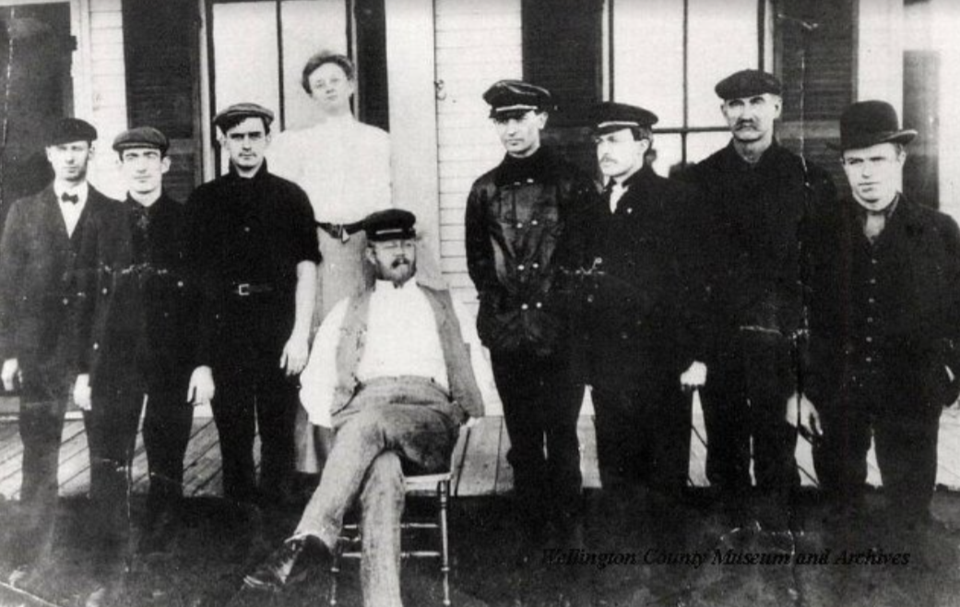Most of us are familiar with the most famous names in the early development of electronic communications: Morse, Bell, Marconi.
The stories of Bell and Marconi in particular have solid connections to Canada. But there is another name less well known, but equally important, that is
connected not only to Canada, but also to Fergus: Fessenden, the electrical engineer who was a pioneer in the field of radio communications. If you have ever enjoyed listening to AM radio, you have him to thank.
Reginald Aubrey Fessenden was born in 1866 in East Bolton in the Eastern Townships of Quebec, one of four sons of reverend Elijah J. Fessenden, an Anglican minister, and his wife Clementina, a writer.
Fessenden’s father was American born, which gave Reginald dual citizenship, and his mother was responsible for the introduction of Empire Day, at one time one of the most important patriotic holidays for Canadian school children.
In 1870 reverend Fessenden was assigned to Fergus to be rector of St. James Anglican Church. Reginald attended Fergus Public School. He was a bright boy who got good marks in mathematics, but otherwise he found school boring. He much preferred reading books from the Fergus Public Library and magazines like the Scientific American.
Reginald evidently had an adventurous spirit, and once got himself lost when he went fishing. According to a somewhat fanciful account by biographer Ormond
Raby, “Even as a child, Reg showed an interest in mathematics beyond his years and delighted in experiments that often both astounded and angered his parents and other adults.”
In January of 1877, young Fessenden was sent to Port Hope to be enroled in Trinity College. He won a prize in mathematics, and his grades in English literature and natural sciences improved. One of his teachers, Peter Perry, left Port Hope for Fergus where he taught school for many years.
At age 14, Fessenden worked part-time in a bank. Then he won a scholarship to Bishop’s College in Lennoxville, Quebec.
While a student there himself, he also taught mathematics, French and Greek. However, he left the school without getting a degree and went to Bermuda to teach.
Fessenden was a great admirer of the American inventor Thomas Edison, whom he compared to the ancient Greek genius Archimedes. In 1886 he went to New York City and found employment with the Edison Machine Works company. Within a year he was promoted and his work had caught the attention of the great man himself.
Edison liked to call him Fezzie.
However, financial difficulties forced Edison to lay Fezzie off in 1890 – right after the young man had married Helen May Trott. The couple would have a son, Reginald Jr. Fessenden soon found new employment with Edison’s rival George Westinghouse, installing electric lighting at the Chicago World’s Fair. Through Westinghouse, Fessenden became the head of the first electrical engineering department at the University of Pittsburgh.
There, Fessenden learned of Guglielmo Marconi’s work transmitting messages by radio waves. He thought he could improve the technology Marconi was working with.
In 1900 the United States Weather Bureau hired Fessenden. The bureau wanted him to see if weather data could be transmitted from remote locations not served by telephone wires. Radio transmitters of that time could only send information via Morse code, which was not adequate for complex weather reports.
Fessenden experimented with a transmitter specially designed to include sound signals. He discovered the principal of amplitude modulation (AM). On December 23, 1900, at Cobb Island, Maryland, Fessenden made history. He successfully transmitted his voice between two towers one mile (1.6 km) apart.
The first words carried by “wireless” transmission were, “One, two, three, four. Is it snowing where you are, Mr. Thiessen (his assistant)? If it is, telegraph back and let me know.” Mr. Thiessen replied by telegraph that it was, in fact, snowing. The first words carried by radio, spoken by a Canadian, concerned snow!
Fessenden’s accomplishment impressed his employer, but it didn’t bring him fame or fortune.
He wasn’t a good businessman. He didn’t know how to promote himself or cultivate a popular public image, and had a reputation for being temperamental and difficult to work with. Fessenden never became as well-known as the other giants in his field, and he soon left the United States Weather Bureau after a dispute over patents.
Fessenden made history again in 1906 when he made what has been deemed the first true radio broadcast to multiple receivers. On Christmas Eve of that year, from Brant Rock, Massachusetts, Fessenden, an amateur musician, played the carol “O Holy Night” on his violin as part of a Yuletide broadcast for ships of the United Fruit Company.
The astonished crewmen then heard him play a recording of the operatic piece “Handel’s Largo.” He closed with a Biblical quotation: “Glory to God in the highest and on earth peace to men of good will.”
Thus, Fessenden was the world’s first live radio performer and the world’s first radio disc jockey.
Over the following years, Fessenden continued his work in radio research and other areas of electronics. He has been credited with over 500 inventions.
One was a primitive form of radar that would help locate icebergs; an idea he had after the Titanic disaster. Fessenden developed the first sonar depth sounding technology, which was subsequently used to detect German U-boats during the First World War.
Fessenden was also involved in engineering the Niagara Falls power plant for the new Hydro-Electric Power Commission of Ontario.
Sometimes Fessenden even ventured onto the turf of his more famous fellow scientists. He made advances in the work pioneered by Morse and Marconi, and even made improvements on the signature invention of his hero Edison, the electric light bulb.
In 1928, Fessenden moved back to Bermuda. He died there on July 22, 1932, and was buried in the cemetery of St. Mark’s Anglican Church; a long way from his old home in Fergus.



